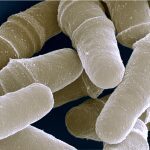Lien vers Pubmed [PMID] – 18658248
Lien vers HAL – Cliquez ici
Lien DOI – 10.1093/nar/gkn441
Nucleic Acids Res. 2008 Sep;36(15):4964-74
Saccharomyces cerevisiae Srs2 helicase plays at least two distinct functions. One is to prevent recombinational repair through its recruitment by sumoylated Proliferating Cell Nuclear Antigen (PCNA), evidenced in postreplication-repair deficient cells, and a second one is to eliminate potentially lethal intermediates formed by recombination proteins. Both actions are believed to involve the capacity of Srs2 to displace Rad51 upon translocation on single-stranded DNA (ssDNA), though a role of its helicase activity may be important to remove some toxic recombination structures. Here, we described two new mutants, srs2R1 and srs2R3, that have lost the ability to hinder recombinational repair in postreplication-repair mutants, but are still able to remove toxic recombination structures. Although the mutants present very similar phenotypes, the mutated proteins are differently affected in their biochemical activities. Srs2R1 has lost its capacity to interact with sumoylated PCNA while the biochemical activities of Srs2R3 are attenuated (ATPase, helicase, DNA binding and ability to displace Rad51 from ssDNA). In addition, crossover (CO) frequencies are increased in both mutants. The different roles of Srs2, in relation to its eventual recruitment by sumoylated PCNA, are discussed.

